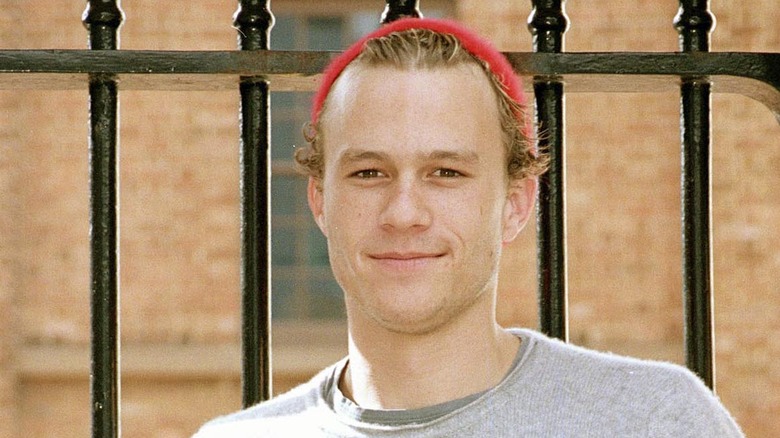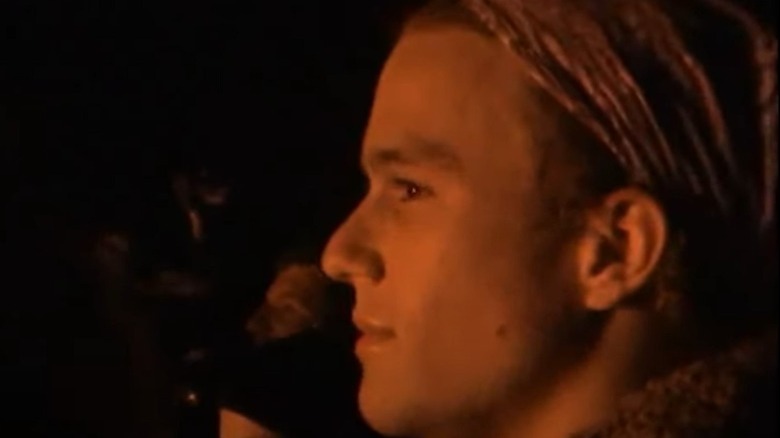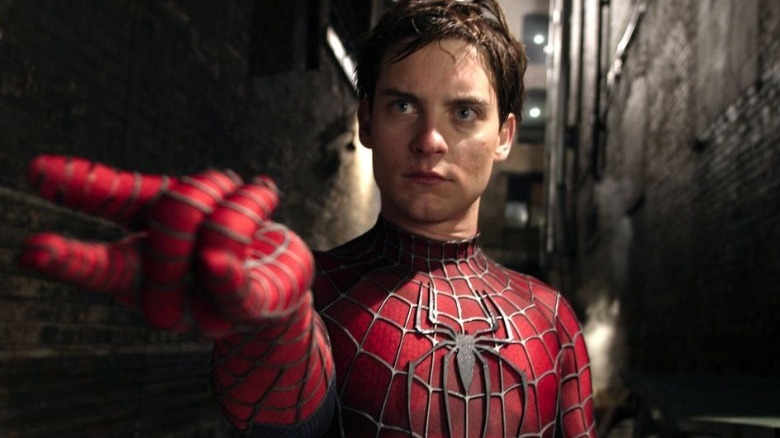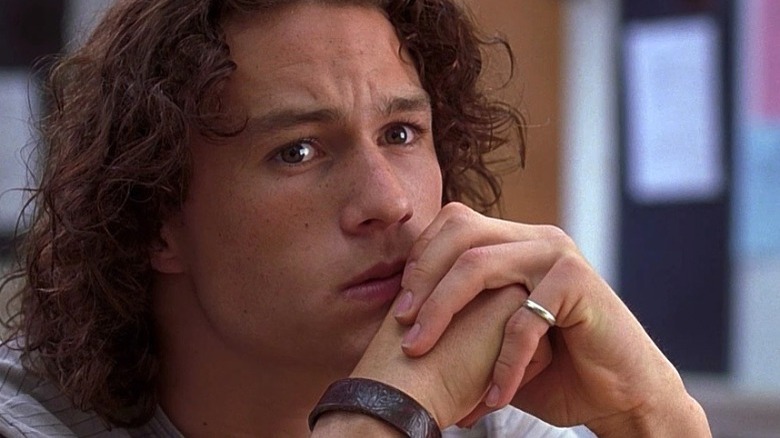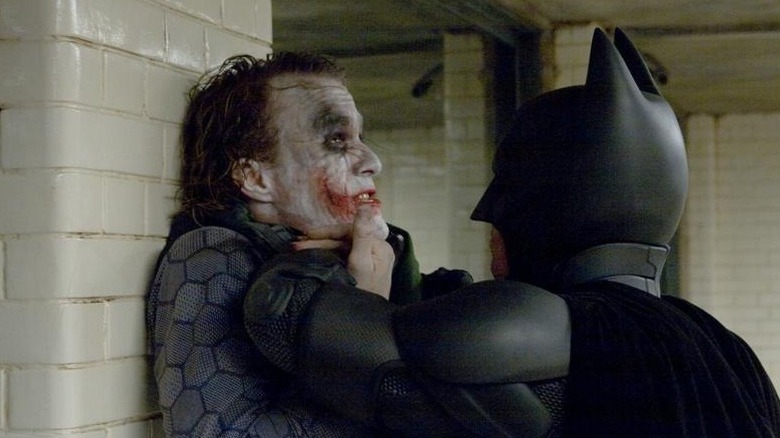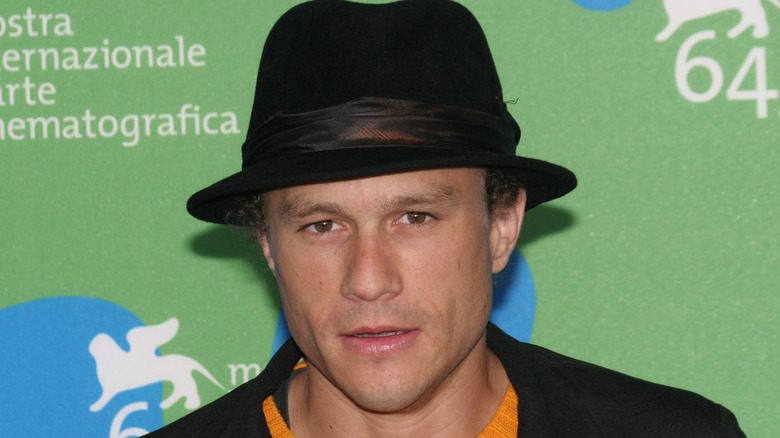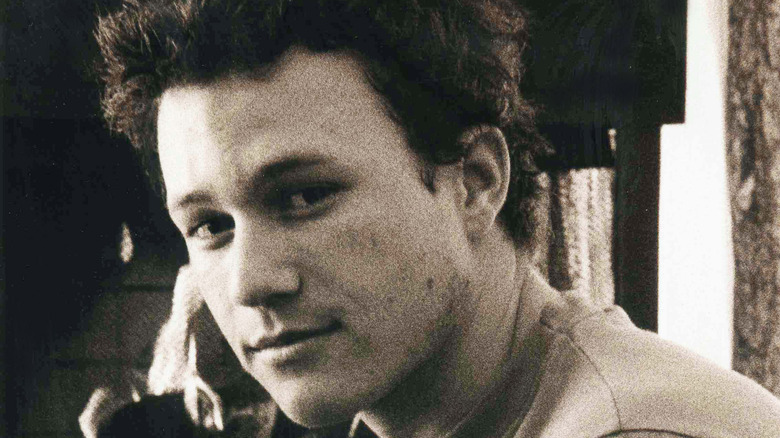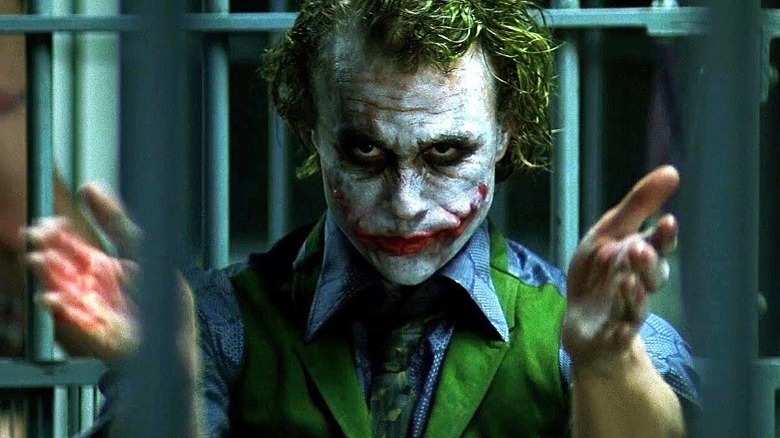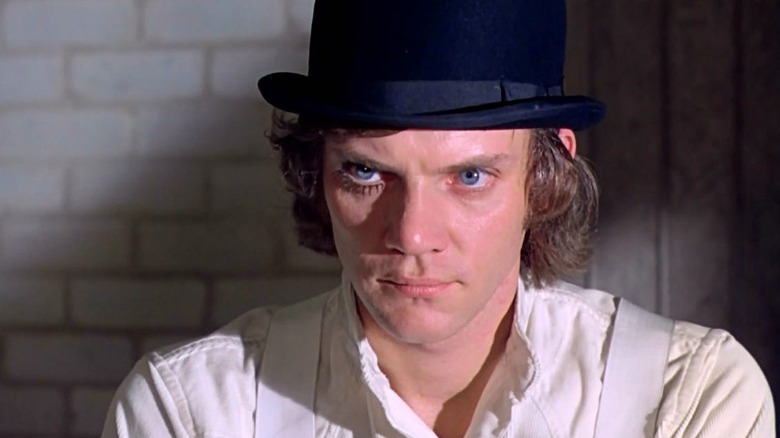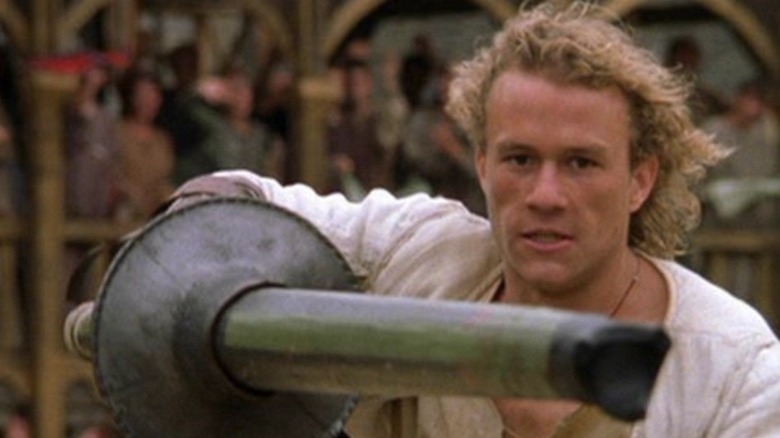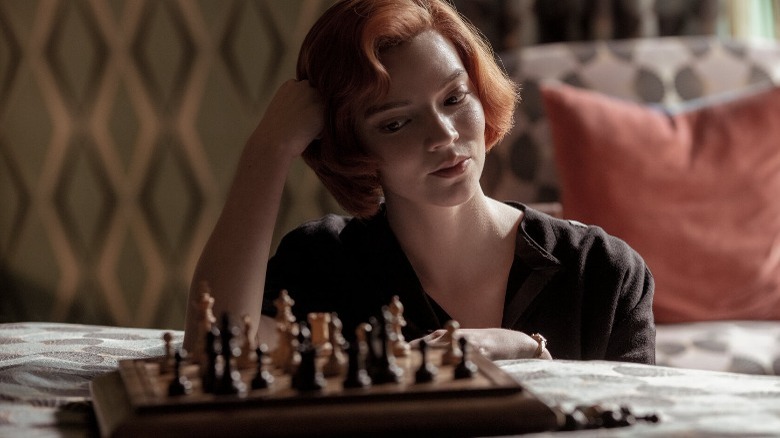The Untold Truth Of Heath Ledger
Devoted to a passion for acting, Heath Ledger solidified his claim to cinematic immortality with defining performances across multiple films in a short span of time. The actor was only 28-years-old at the time of his passing but managed to accomplish far more in just a few years than many artists do in a lifetime. Always eager to move on to the next big project, Ledger was highly productive and graceful despite his fame.
Ledger broke into stardom with his leading role as Patrick Verona in the romantic-comedy "10 Things I Hate About You." He was only 20-years-old at the time but left an indelible mark on the film that paved the way for his talent to be seen in future productions. Ledger's filmography includes many memorable movies from the '00s, such as "The Patriot," "A Knight's Tale," "Lords of Dogtown," "Brokeback Mountain," and, of course, "The Dark Knight."
Despite a busy life as an actor, Ledger began a relationship with actress Michelle Williams following their work together on "Brokeback Mountain," and the couple shared a daughter, Matilda. The pair split in 2007, but Ledger remained a passionate family man focused on his daughter and her care. His life, interests, and art have been highlighted by fans in the years since his death. Here is the untold truth of Heath Ledger.
Ledger was a young chess enthusiast
Many would come to know Heath Ledger as his public profile grew, but not everyone was aware that he was something of a Renaissance man. While he held a deep interest in art, music, and acting, Ledger was also a slayer of kings at the chess table. At a young age, he began playing chess almost daily. He even likened it to an obsession instead of a mere hobby. The actor bucked the stereotype of chess players and their supposed social oddities as Ledger was clearly an outgoing individual in many areas of his life.
His fascination with the game would influence the actor in his adult years as well. Towards the end of his life, Ledger was involved in a planned adaptation of the Walter Tevis novel "The Queen's Gambit," as reported by The Independent in 2008. After Ledger played the Joker, many of his friends commented on the actor's insomnia. His mind would race and never allow him to fully shut down for a healthy night's rest, similar to how Beth Harmon is described in "The Queen's Gambit." Ledger may have felt an element of kinship with the fictional champion chess player.
The actor constantly filmed video diaries
In the documentary "I Am Heath Ledger," viewers catch glimpses of the late actor's daily life, often in footage that Ledger took himself. Former flame and Australian model Christina Cauchi explained in the documentary that Ledger always had cameras around him as he was eager to capture every moment. The model had a strong bond and intimate relationship with Ledger during the years that they were together. Ledger documented their best moments in both film and photography. Cauchi stated, "The way he was able to be in the moment and then capture the moment on the camera, he just got you in your most authentic self." She continued, "Because he's saying, you know, through his photographs, 'I see you.'"
As shown in "I Am Heath Ledger," the actor would enhance his photographs by drawing on them with crayons, painting them with nail polish, or even scratching the film to add a surreal element to each picture. As his childhood friends share in the documentary, he acted as if he was highly aware of his mortality, constantly taking life in and savoring it through art, photography, and film. Part of the actor's brilliance was his desire to experience everything. His talents seen both in front of and behind the camera were a reflection of that fire within him.
Ledger attended Burning Man in 1999
Ledger's childhood friend, Trevor DiCarlo, was always by the actor's side before his career began and long after it took off. After finishing filming "The Patriot," Ledger, DiCarlo, and a few of their friends decided to head out to Burning Man, the massive desert musical and arts festival held annually in Black Rock, Nevada. The group had no idea what the event was about, but they were always looking for a new adventure. Upon arrival, Ledger was instantly enthralled by the culture of freedom and artistic expression that permeated the festival.
In the documentary "I Am Heath Ledger," another friend of the actor describes Burning Man as "Heath's favorite place on Earth," via Acclaim Magazine. The festival's focus on music and art helped make the event a supreme experience for Ledger. While his artistry took shape in his filming, photography, and acting, music was also a significant part of Ledger's life. He'd eventually work on musical projects as a side note in his career, even founding a record label with Ben Harper, Masses Music Co., in 2007.
Ledger turned down the roles of Spider-Man and Batman
While Heath Ledger's role as the Joker is iconic, his superhero career could have begun much earlier. His agent, Steven Alexander, was given a script for Sam Raimi's "Spider-Man," which Ledger quickly rejected. In an interview with Entertainment Weekly magazine (via Express), Alexander stated, "Sony asked me to come over and read the script for 'Spider-Man.' It was going to be a really cool tentpole movie." Alexander continued, "But as soon as I said 'Spider-Man' Heath said, 'It's not for me, I would be taking someone else's dream away.'" That revelation also demonstrated Ledger to be a real class act, as he only took on roles that he was truly invested in. As fans know, Tobey Maguire would play the part of the famous web-slinger for three films.
Following the release of "The Dark Knight Rises," Christopher Nolan sat down with IndieWire for an interview. During that conversation, Nolan discussed casting the role of Batman. The director acknowledged that he met with many actors for the part and noted that Ledger was one of them. However, though Ledger did speak with Nolan, he almost instantly turned down the film. Nolan remembered, "He was quite gracious about it, but he said, 'I would never take a part in a superhero film.'" Well, never say never, indeed. After Ledger saw what Nolan achieved with "Batman Begins," he quickly contacted the director to participate in the follow-up film.
Ledger refused to be typecast based on past roles
Anyone who knew Heath Ledger intimately knew that he couldn't be put into a box. A constant craving for artistic expression pushed Ledger to seek new challenges while creating something fresh and different. Being cast as Patrick Verona in "10 Things I Hate About You" was a significant moment for the late actor as it pushed him into the spotlight and prepared him for Hollywood stardom. Almost immediately, the Australian actor was recognized as a teen heartthrob anchoring one of the biggest romantic comedies of the year. The film was a success, and Heath Ledger established himself as a magnetic personality.
Following the film's release, Ledger received several offers for new acting jobs in Hollywood due to his sudden popularity. Many of those offers were for similar roles in other romantic comedy projects, but the actor refused to be typecast. In fact, Ledger didn't work for nearly a year, rejecting every offer that came his way for another rom-com project, via Cinema Blend. Eventually, he'd land a role starring opposite of Mel Gibson in "The Patriot." His pursuit of new challenges blossomed into a career of varied roles and experiences. After all, going from a teen heartthrob to a crazed anarchist Batman villain is quite a leap.
Ledger requested that Christian Bale hit him during scenes
Ledger's commitment to his roles extended far beyond the cameras. The actor prepared for his parts both on and off set by going full method at times. According to the documentary "I Am Heath Ledger," he isolated himself for nearly six weeks to get into the headspace of the Joker, practicing lines and creating the voice he wanted to use. The actor even tempted one of his famous co-stars to hit him while filming an interrogation scene.
In the book "100 Things Batman Fans Should Know & Do Before They Die," author Joseph McCabe shares an interview with director Christopher Nolan and Christian Bale, who portrayed Batman in Nolan's trilogy. The Hollywood Reporter reprinted one of those interviews, in which Bale stated, "He was kinda egging me on. I was saying, 'You know what, I really don't need to actually hit you. It's going to look just as good if I don't.' And he's going, 'Go on. Go on. Go on ...' He was slamming himself around, and there were tiled walls inside of that set which were cracked and dented from him hurling himself into them. His commitment was total." Ledger's portrayal would earn the actor a posthumous Oscar for his portrayal of the Joker, an award he clearly earned.
Directing music videos became a passion for the actor
Acting was a dream come true for the young thespian. However, while Ledger achieved a great deal in Hollywood, he also hoped to branch out one day be a director. With the help of some musically gifted friends, Ledger began filming music videos. His work began with a childhood friend, N'fa Jones, for whom Ledger directed in the music video of his song "Cause and Effect." In between acting gigs, Ledger would return to a seat behind the director's chair. Ledger would eventually film the video "Morning Yearning," a song performed by his close friend Ben Harper.
Ledger's interest in music would continue as he continually sought out new talent. He eventually announced plans to begin his own record label with Harper, Masses Music Co. As seen in the documentary, "I Am Heath Ledger," Harper praised Ledger's work and shared that he felt the music video Ledger directed was the best video he ever had under his belt during the entirety of his career. Harper also stated that he believed that Ledger would have had an equally prominent career behind the camera as he did in front of it.
Ledger put his energy into a small record label he co-created
In order to broaden his career his independent talent and creativity, Ledger worked with his friend Matt Amato, who co-founded an art collective under the name of The Masses. Amato and Ledger were equally interested in music and made plans to establish a small indie record label, Masses Music Co. In recorded audio presented in the documentary "I Am Heath Ledger," the actor stated, "I work with bands. I direct music videos, and I run a small independent label, The Masses, and it's with a whole bunch of my friends who are all just young creators."
He actively sought out talent and even helped young artists like Australian musician Grace Woodroofe get their albums produced, as noted by The Sydney Morning Herald. Ledger even stepped behind the camera to film videos for these burgeoning artists. Like every aspect of his life, when Ledger set out to do something, he fully committed.
Ledger improvised many scenes in The Dark Knight
As an actor, Ledger went beyond delivering lines, and he had a significant amount of input in creating the Joker persona in "The Dark Knight." Multiple iconic scenes from the film were a product of the actor's improvisation. When the Joker allows himself to be captured and imprisoned, he is seen clapping studiously while Jim Gordon (Gary Oldman) is crowned as police commissioner by the mayor. Ledger embraced the maniacal villain he played and improvised that moment where the Joker applauds the new commissioner.
Christopher Nolan confirmed that the late actor improvised this scene. When Nolan was asked about other moments of improvisation by the late actor in a BBC Radio 1 interview, the director stated, "A lot of what Heath did, he would discuss with me, but, he'd sort of give me hints about what he was going to do. And we'd talk about it a bit, and I would try and be an audience for him, or sort of gauge with him what he was doing. But a lot of it was about unpredictability. And I think he wanted to play his cards a little close to the chest." Nolan went on to say that much of the Joker's vocal tones were created by Ledger without the director knowing how the actor planned to deliver his lines beforehand.
Ledger's famous Joker diary became legendary
The actor plunged into the depths of his characters with great devotion. For his penultimate performance, Ledger prepared perhaps longer than any other role. Since the actor signed on for the part long before a script was available, he had ample opportunity to research the character and develop his version of the Joker for the big screen. One of his methods included maintaining a diary about his ideas and fixations on building the Joker character.
The Joker diary has become the stuff of urban legend and twisted conspiracy. Despite the rumors and sensationalism behind the book and its supposedly disturbing nature, it was not much more than an assembly of ideas, lines, and pictures depicting the Joker character. Among the writings and images in the diary were references to the 1971 Stanley Kubrick film, "A Clockwork Orange." Ledger's Joker took inspiration from that film's psychotic Alex DeLarge character as performed by Malcolm McDowell. The diary also indicates that he honed his Joker laugh by mimicking hyenas. Despite what anyone may think of the journal, it helped Ledger craft an unforgettable performance.
Ledger had imposter syndrome
During the marketing for "A Knight's Tale," Ledger was front and center on the film's advertising campaign with an up-close image of his face on movie posters. In the documentary, "I Am Heath Ledger," his agent Steven Alexander and friend N'fa Jones recognized how uncomfortable he quickly became. The actor was scheduled to sell the film in press junket after press junket, and he almost lost his nerve. Matt Amato stated, "He wanted fame. And then when he got it, he didn't want it." The whirlwind shock that came with a new level of renown struck the actor hard.
Like many artists, Ledger grappled with self-doubt. He often felt there was a chance his performances could be better or that he simply hadn't hit the mark. In a recorded conversation on the PBS interview program Blank on Blank, Ledger commented on his consistent nervous energy, saying, "It's a pattern for me, going into any job carrying a certain level of anxieties and doubt, self-doubt, fears toward my inabilities and not being able to. I fooled them, or I can't do this. I'm not an actor. I shouldn't be here. I think everyone goes through that. I certainly do." The moments of negative introspection would pass, but Ledger always seemed to experience them throughout his career.
Ledger was set to direct a film based on the novel The Queen's Gambit
While Ledger never directed a full-length feature film, that was most certainly the plan if it weren't for his untimely death. At the time of his passing, the actor was attached to direct an adaptation of the Walter Tevis novel "The Queen's Gambit" as a feature film, which was produced as a limited Netflix series in 2020. Ledger's friends have indicated that the project instantly attracted the actor. The story revolves around an isolated girl who excels at chess while struggling with addiction to medications. Considering that Isolation, addiction, and chess are all things the actor understood very well if there was anyone perfect for envisioning this story to unfold on camera, it was Heath Ledger.
While Anya Talyor-Joy eventually took the lead role of Beth Harmon, Ledger had earmarked Elliot Page for the role, per UPROXX. Ultimately, the director of the Netflix series, Scott Frank, shared with NPR that a film adaptation wouldn't have done the novel justice. He stated that a runtime of two hours would reduce the film to a "sports movie" focused on whether the main character would win and not about her growth and struggles. Despite those concerns, it would've been interesting to see Heath Ledger tackle the project in a directorial debut.

